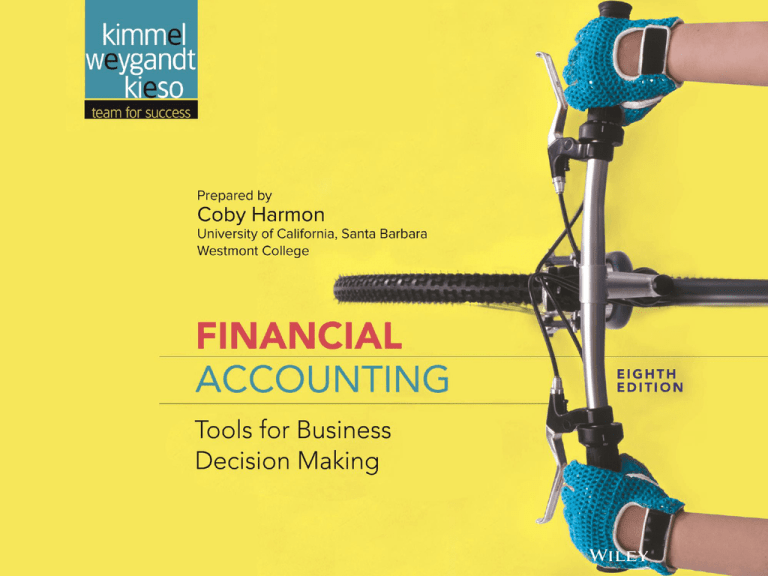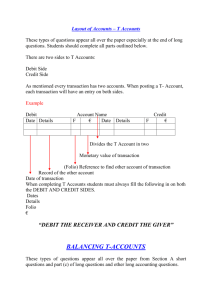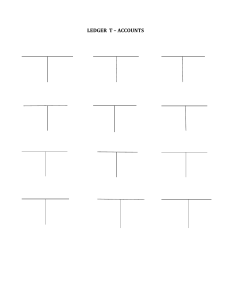
3-1
3
The Accounting Information
System
Kimmel ● Weygandt ● Kieso
Financial Accounting, Eighth Edition
3-2
CHAPTER OUTLINE
LEARNING OBJECTIVES
3-3
1
Analyze the effect of business transactions on the basic
accounting equation.
2
Explain how accounts, debits, and credits are used to
record business transactions.
3
Indicate how a journal is used in the recording process.
4
Explain how a ledger and posting help in the recording
process.
5
Prepare a trial balance.
LEARNING
OBJECTIVE
1
Analyze the effect of business transactions on
the basic accounting equation.
Accounting Information System
System of
3-4
►
collecting and
►
processing transaction data and
►
communicating financial information to decision-makers.
LO 1
Accounting Information System
Accounting information systems rely on a process referred
to as the accounting cycle.
Analyze
business
transactions
Adjusted
Trial
Balance
Journalize
Financial
Statements
Post
Trial
Balance
Closing
Entries
Adjusting
Entries
Post-Closing
Trial Balance
Most businesses use computerized accounting systems.
3-5
LO 1
ACCOUNTING TRANSACTIONS
Transactions are economic events that require recording
in the financial statements.
Not all activities represent transactions.
Assets, liabilities, or stockholders’ equity items change
as a result of some economic event.
3-6
Dual effect on the accounting equation.
LO 1
ACCOUNTING TRANSACTIONS
Question: Are the following events recorded in
the accounting records?
Discuss guided trip
options with potential
customer
Illustration 3-1
Transaction
identification process
Event
Purchase
computer
Criterion
Is the financial position (assets, liabilities, or
stockholders’ equity) of the company changed?
Pay rent
Record/ Don’t
Record
3-7
LO 1
ANALYZING TRANSACTIONS
The process of identifying the specific effects of economic
events on the accounting equation.
Basic Accounting Equation
Assets
3-8
=
Liabilities
+
Stockholders’
Equity
LO 1
ANALYZING TRANSACTIONS
Illustration 3-2
Expanded accounting equation
3-9
LO 1
ANALYZING TRANSACTIONS
Event (1). On October 1, cash of $10,000 is invested in Sierra Corporation
by investors in exchange for $10,000 of common stock.
1. +10,000
3-10
+10,000
LO 1
ANALYZING TRANSACTIONS
Event (2). On October 1, Sierra borrowed $5,000 from Castle Bank by
signing a 3-month, 12%, $5,000 note payable.
1. +10,000
2. +5,000
3-11
+10,000
+5,000
LO 1
ANALYZING TRANSACTIONS
Event (3). On October 2, Sierra purchased equipment by paying $5,000
cash to Superior Equipment Sales Co.
1. +10,000
2. +5,000
3. -5,000
3-12
+10,000
+5,000
+5,000
LO 1
ANALYZING TRANSACTIONS
Event (4). On October 2, Sierra received a $1,200 cash advance from R.
Knox, a client.
1. +10,000
2. +5,000
3. -5,000
4. +1,200
3-13
+10,000
+5,000
+5,000
+1,200
LO 1
ANALYZING TRANSACTIONS
Event (5). On October 3, Sierra received $10,000 in cash from Copa
Company for guide services performed.
1. +10,000
2. +5,000
3. -5,000
4. +1,200
5. +10,000
3-14
+10,000
+5,000
+5,000
+1,200
+10,000
LO 1
ANALYZING TRANSACTIONS
Event (6). On October 3, Sierra Corporation paid its office rent for the
month of October in cash, $900.
1. +10,000
2. +5,000
3. -5,000
4. +1,200
5. +10,000
6.
3-15
-900
+10,000
+5,000
+5,000
+1,200
+10,000
-900
LO 1
ANALYZING TRANSACTIONS
Event (7). On October 4, Sierra paid $600 for a one-year insurance policy
that will expire next year on September 30.
1. +10,000
+10,000
2. +5,000
3. -5,000
+5,000
+5,000
4. +1,200
+1,200
5. +10,000
6.
-900
7.
-600
3-16
+10,000
-900
+600
LO 1
ANALYZING TRANSACTIONS
Event (8). On October 5, Sierra purchased an estimated three months of
supplies on account from Aero Supply for $2,500.
1. +10,000
+10,000
2. +5,000
3. -5,000
+5,000
+5,000
4. +1,200
+1,200
5. +10,000
6.
-900
7.
-600
8.
3-17
+10,000
-900
+600
+2,500
+2,500
LO 1
ANALYZING TRANSACTIONS
Event (9). On October 9, Sierra hired four new employees to begin work
on October 15.
1. +10,000
+10,000
2. +5,000
3. -5,000
+5,000
+5,000
4. +1,200
+1,200
5. +10,000
6.
-900
7.
-600
8.
+10,000
-900
+600
+2,500
+2,500
An accounting transaction has not occurred.
3-18
LO 1
ANALYZING TRANSACTIONS
Event (10). On October 20, Sierra paid a $500 dividend.
1. +10,000
+10,000
2. +5,000
3. -5,000
+5,000
+5,000
4. +1,200
+1,200
5. +10,000
6.
-900
7.
-600
8.
10.
3-19
+10,000
-900
+600
+2,500
-500
+2,500
-500
LO 1
ANALYZING TRANSACTIONS
Event (11). Employees have worked two weeks, earning $4,000 in
salaries, which were paid on October 26.
1. +10,000
+10,000
2. +5,000
3. -5,000
+5,000
+5,000
4. +1,200
+1,200
5. +10,000
6.
-900
7.
-600
8.
10. -500
11. -4,000
3-20
+10,000
-900
+600
+2,500
+2,500
-500
-4,000
LO 1
INVESTOR INSIGHT
Why Accuracy Matters
While most companies record transactions very carefully, the reality is that
mistakes still happen. For example, bank regulators fi ned Bank One
Corporation (now JPMorgan Chase) $1.8 million because they felt that the
unreliability of the bank’s accounting system caused it to violate regulatory
requirements. Also, in recent years Fannie Mae, the government chartered
mortgage association, announced a series of large accounting errors. These
announcements caused alarm among investors, regulators, and politicians
because they feared that the errors might suggest larger, undetected problems.
This was important because the home-mortgage market depends on Fannie
Mae to buy hundreds of billions of dollars of mortgages each year from banks,
thus enabling the banks to issue new mortgages. Finally, before a major
overhaul of its accounting system, the financial records of Waste Management
Company were in such disarray that of the company’s 57,000 employees,
10,000 were receiving pay slips that were in error. The Sarbanes-Oxley Act
was created to minimize the occurrence of errors like these by increasing every
employee’s responsibility for accurate financial reporting.
3-21
LO 1
DO IT!
1
Transaction Analysis
A tabular analysis of the transactions for the month of August is
shown below. Describe each transaction.
1. Company issued shares of stock for $25,000 cash.
2. Company purchased $7,000 of equipment on account.
3. Company received $8,000 cash in exchange for services performed.
4. Company paid $850 for this month’s rent.
3-22
LO 1
LEARNING
OBJECTIVE
2
Explain how accounts, debits, and credits are
used to record business transactions.
Debit and Credit Procedures
Double-entry system
Each transaction must affect two or more accounts to
keep the basic accounting equation in balance.
Recording done by debiting at least one account and
crediting another.
3-23
DEBITS must equal CREDITS.
LO 2
DEBIT AND CREDIT PROCEDURES
If Debits are greater than Credits, the account will have a
debit balance.
Account Name
Debit / Dr.
Credit / Cr.
Transaction #1
$10,000
$3,000
Transaction #3
8,000
Balance
3-24
Transaction #2
$15,000
LO 2
DEBIT AND CREDIT PROCEDURES
If Debits are greater than Credits, the account will have a
debit balance.
Account Name
Transaction #1
Balance
3-25
Debit / Dr.
Credit / Cr.
$10,000
$3,000
Transaction #2
8,000
Transaction #3
$1,000
LO 2
Procedures for Assets and Liabilities
Assets
Debit / Dr.
Assets - Debits should exceed
credits.
Liabilities – Credits should
exceed debits.
Credit / Cr.
Normal Balance
Chapter
3-23
Liabilities
Debit / Dr.
Credit / Cr.
▼ HELPFUL HINT
The normal balance is the
side where increases in
the account are recorded.
Normal Balance
Chapter
3-24
3-26
LO 2
Procedures for Stockholders’ Equity
Stockholders’ Equity
Investments by stockholders and
revenues increase stockholders’
equity (credit).
Dividends and expenses decrease
stockholder’s equity (debit).
Credit / Cr.
Debit / Dr.
Normal Balance
Chapter
3-25
Common Stock
Debit / Dr.
Retained Earnings
Credit / Cr.
Debit / Dr.
Normal Balance
Chapter
3-25
3-27
Chapter
3-25
Dividends
Credit / Cr.
Debit / Dr.
Normal Balance
Normal Balance
Credit / Cr.
Chapter
3-23
LO 2
Procedures for Stockholders’ Equity
Revenue
Debit / Dr.
Revenues increase stockholder’s
equity.
Expenses have the opposite
effect: expenses decrease
stockholders’ equity.
The effect of debits and credits
on revenue and expense
accounts is the same as their
effect on stockholders’ equity.
Credit / Cr.
Normal Balance
Chapter
3-26
Expense
Debit / Dr.
Normal Balance
Credit / Cr.
Chapter
3-27
3-28
LO 2
INVESTOR INSIGHT
Chicago Cubs
Keeping Score
The Chicago Cubs baseball team has these major revenue and
expense accounts:
Revenues
3-29
Expenses
Admissions (ticket sales)
Players’ salaries
Concessions
Administrative salaries
Television and radio
Travel
Advertising
Ballpark maintenance
LO 2
STOCKHOLDERS’
EQUITY
RELATIONSHIPS
ILLUSTRATION 3-15
Stockholders’ equity
relationships
3-30
LO 2
DEBIT/CREDIT RULES
Liabilities
Debit / Dr.
Normal
Balance
Credit
Normal
Balance
Debit
Credit / Cr.
Normal Balance
Chapter
3-24
Stockholders’ Equity
Assets
Credit / Cr.
Debit / Dr.
Debit / Dr.
Normal Balance
Normal Balance
Chapter
3-23
Chapter
3-25
Revenue
Expense
Debit / Dr.
Debit / Dr.
Credit / Cr.
3-31
Credit / Cr.
Normal Balance
Normal Balance
Chapter
3-27
Credit / Cr.
Chapter
3-26
LO 2
SUMMARY OF DEBIT/CREDIT RULES
Balance Sheet
Asset
= Liability + Equity
Income Statement
Revenue - Expense =
Debit
Credit
3-32
LO 2
SUMMARY OF DEBIT/CREDIT RULES
Relationship among the assets, liabilities and stockholders’
equity of a business:
ILLUSTRATION 3-16
Basic
Equation
Assets = Liabilities +
Stockholders’ Equity
Expanded
Basic
Equation
The equation must be in balance after every transaction.
For every Debit there must be a Credit.
3-33
LO 2
SUMMARY OF DEBIT/CREDIT RULES
Review Question
Debits:
a. increase both assets and liabilities.
b. decrease both assets and liabilities.
c. increase assets and decrease liabilities.
d. decrease assets and increase liabilities.
3-34
LO 2
SUMMARY OF DEBIT/CREDIT RULES
Review Question
Accounts that normally have debit balances are:
a. assets, expenses, and revenues.
b. assets, expenses, and equity.
c. assets, liabilities, and dividends.
d. assets, dividends, and expenses.
3-35
LO 2
LEARNING
OBJECTIVE
3
Indicate how a journal is used in the
recording process.
The Recording Process
1. Analyze each transaction in terms of its effect on the
accounts.
2. Enter the transaction information in a journal.
3. Transfer the journal information to the appropriate accounts
in the ledger.
Analyze
business
transactions
3-36
Journalize
the
transaction
Post to
ledger
accounts
LO 3
THE RECORDING PROCESS
Analyze
business
transactions
Journalize the
transaction
Post to
ledger
accounts
ILLUSTRATION 3-17
The recording process
Analyze
transaction
Enter
transaction
3-37
Transfer from journal to
ledger
LO 3
THE JOURNAL
Transactions recorded in chronological order in a
journal before they are transferred to the accounts.
Contributions to the recording process:
1. Discloses the complete effects of a transaction.
2. Provides a chronological record of transactions.
3. Helps to prevent or locate errors because the debit
and credit amounts can be easily compared.
3-38
LO 3
THE JOURNAL
Journalizing - Entering transaction data in the journal.
Illustration: Presented below is information related to Sierra
Corporation.
Oct. 1 Sierra issued common stock in exchange for
$10,000 cash.
1 Sierra borrowed $5,000 by signing a note.
2 Sierra purchased equipment for $5,000.
Instructions - Journalize these transactions.
3-39
LO 3
THE JOURNAL
Oct. 1 Sierra issued common stock in exchange for
$10,000 cash.
General Journal
3-40
Date
Account Title
Oct. 1
Cash
Common Stock
Ref.
Debit
Credit
10,000
10,000
LO 3
THE JOURNAL
Oct. 1 Sierra borrowed $5,000 by signing a note.
General Journal
Date
Oct. 1
3-41
Account Title
Cash
Notes Payable
Ref.
Debit
Credit
5,000
5,000
LO 3
THE JOURNAL
Oct. 2 Sierra purchased equipment for $5,000.
General Journal
Date
Oct. 2
3-42
Account Title
Equipment
Cash
Ref.
Debit
Credit
5,000
5,000
LO 3
THE JOURNAL
ILLUSTRATION 3-18
Recording transactions in
journal form
3-43
LO 3
ACCOUNTING ACROSS THE ORGANIZATION
Boosting Profits
Microsoft originally designed the Xbox 360 to have 256 megabytes of memory.
But the design department said that amount of memory wouldn’t support the best
special effects. The purchasing department said that adding more memory would
cost $30—which was 10% of the estimated selling price of $300. The marketing
department, however, “determined that adding the memory would let Microsoft
reduce marketing costs and attract more game developers, boosting royalty
revenue. It would also extend the life of the console, generating more sales.” As a
result of these changes, Xbox enjoyed great success. But, it does have
competitors. Its newest video game console, Xbox One, is now in a battle with
Sony’s Playstation4 for market share. How to compete? First, Microsoft bundled
the critically acclaimed Titan fall with its Xbox One. By including the game most
Xbox One buyers were going to purchase anyway, Microsoft was making its
console more attractive. In addition, retailers are also discounting the Xbox,
which should get the momentum going for increased sales. What Microsoft is
doing is making sure that Xbox One is the center of the home entertainment
system in the long run.
3-44
LO 3
DO IT!
3
Journal Entries
The following events occurred during the first month of business of Hair
It Is Inc., Kate Browne’s beauty salon:
1. Issued common stock to shareholders in exchange for $20,000
cash.
2. Purchased $4,800 of equipment on account (to be paid in 30 days).
3. Interviewed three people for the position of stylist.
The three activities are recorded as follows:
1.
2.
3.
3-45
Cash
Common Stock
Equipment
Accounts Payable
20,000
20,000
4,800
4,800
No entry because no transaction occurred.
LO 3
LEARNING
OBJECTIVE
4
Explain how a ledger and posting help in
the recording process.
The Accounting Cycle
Analyze
business
transactions
Adjusted
Trial
Balance
3-46
Journalize
the
transaction
Financial
Statements
Post to
ledger
accounts
Closing
Entries
Trial
Balance
Adjusting
Entries
Post-Closing
Trial Balance
LO 4
THE LEDGER
The Ledger is comprised of the entire group of accounts
maintained by a company.
ILLUSTRATION 3-19
The general ledger
3-47
LO 4
CHART OF ACCOUNTS
Listing of accounts used by a company to record
transactions.
ILLUSTRATION 3-20
Chart of accounts for Sierra
Corporation
3-48
LO 4
POSTING
The process of transferring journal entry amounts to ledger
accounts.
General Journal
Date
Oct. 1
Account Title
J1
Ref.
101
Cash
Debit
10,000
Credit
10,000
Common Stock
General Ledger
Cash
Date
Oct. 1
3-49
Explanation
Stock issued
Acct. No. 101
Ref.
Debit
J1
10,000
Credit
Balance
10,000
LO 4
POSTING
Review Question
Posting:
a. normally occurs before journalizing.
b. transfers ledger transaction data to the journal.
c. is an optional step in the recording process.
d. transfers journal entries to ledger accounts.
3-50
LO 4
ETHICS INSIGHT
Credit Suisse Group
A Convenient Overstatement
Sometimes a company’s investment securities suffer a permanent decline in
value below their original cost. When this occurs, the company is supposed
to reduce the recorded value of the securities on its balance sheet (“write
them down” in common financial lingo) and record a loss. It appears,
however, that during the financial crisis of 2008, employees at some financial
institutions chose to look the other way as the value of their investments
skidded. A number of Wall Street traders that worked for the investment bank
Credit Suisse Group were charged with intentionally overstating the value of
securities that had suffered declines of approximately $2.85 billion. One
reason that they may have been reluctant to record the losses is out of fear
that the company’s shareholders and clients would panic if they saw the
magnitude of the losses. However, personal self-interest might have been
equally to blame—the bonuses of the traders were tied to the value of the
investment securities.
Source: S. Pulliam, J. Eaglesham, and M. Siconolfi , “U.S. Plans Changes on
Bond Fraud,” Wall Street Journal Online (February 1, 2012).
3-51
LO 4
RECORDING PROCESS ILLUSTRATED
Follow these steps:
1. Determine what
type of account is
involved.
2. Determine what
items increased or
decreased and by
how much.
3. Translate the
increases and
decreases into
debits and credits.
ILLUSTRATION 3-21
Investment of cash by
stockholders
3-52
LO 4
3-53
ILLUSTRATION 3-22
LO 4
3-54
ILLUSTRATION 3-23
LO 4
3-55
ILLUSTRATION 3-24
LO 4
3-56
ILLUSTRATION 3-25
LO 4
3-57
ILLUSTRATION 3-26
LO 4
3-58
ILLUSTRATION 3-27
LO 4
3-59
ILLUSTRATION 3-28
LO 4
ILLUSTRATION 3-29
3-60
LO 4
3-61
ILLUSTRATION 3-30
LO 4
3-62
ILLUSTRATION 3-31
LO 4
JOURNALIZING SUMMARY
3-63
ILLUSTRATION 3-32
General journal for
Sierra Corporation
LO 4
Illustration 3-32
3-64
LO 4
POSTING
SUMMARY
ILLUSTRATION 3-33
General ledger for
Sierra Corporation
3-65
DO IT!
4
Posting
Selected transactions from the journal of Faital Inc. during its first month of
operations are presented below. Post these transactions to T-accounts.
3-66
LO 4
LEARNING
OBJECTIVE
5 Prepare a trial balance.
The Accounting Cycle
Analyze
business
transactions
Adjusted
Trial
Balance
3-67
Journalize
the
transaction
Financial
Statements
Post to
ledger
accounts
Closing
Entries
Prepare
a Trial
Balance
Adjusting
Entries
Post-Closing
Trial Balance
LO 5
TRIAL BALANCE
3-68
A list of accounts and their balances at a given time.
Accounts are listed in the order in which they appear
in the ledger.
Purpose is to prove that debits
equal credits.
May also uncover errors in
journalizing and posting.
Useful in the preparation of
financial statements.
▼ HELPFUL HINT
Note that the order of
presentation in the trial
balance is:
Assets
Liabilities
Stockholders’ equity
Revenues
Expenses
LO 5
TRIAL BALANCE
3-69
ILLUSTRATION 3-34
Sierra Corporation
trial balance
LO 5
LIMITATIONS OF A TRIAL BALANCE
The trial balance may balance even when
1. a transaction is not journalized,
2. a correct journal entry is not posted,
3. a journal entry is posted twice,
4. incorrect accounts are used in
journalizing or posting, or
5. offsetting errors are made in
recording the amount of a
ETHICS NOTE An error is
the result of an unintentional
mistake. It is neither ethical
nor unethical. An irregularity
is an intentional
misstatement, which is
viewed as unethical.
transaction.
3-70
LO 5
TRIAL BALANCE
Review Question
A trial balance will not balance if:
a.
a correct journal entry is posted twice.
b.
the purchase of supplies on account is debited to
Supplies and credited to Cash.
c. a $100 cash dividends is debited to the Dividends
account for $1,000 and credited to Cash for $100.
d. a $450 payment on account is debited to Accounts
Payable for $45 and credited to Cash for $45.
3-71
LO 5
DO IT!
5
Trial Balance
The following accounts come from the ledger of SnowGo
Corporation at December 31, 2017.
Equipment
Dividends
$88,000
8,000
Accounts Payable
22,000
Salaries and Wages
Expense
42,000
Accounts Receivable
4,000
Service Revenue
95,000
Common Stock
$20,000
Salaries and Wages
Payable
2,000
Notes Payable (due in
3 months)
19,000
Utilities Expense
3,000
Prepaid Insurance
6,000
Cash
7,000
Prepare a trial balance in good form.
3-72
LO 5
3-73
LO 5
A Look at IFRS
LEARNING
OBJECTIVE
6
Compare the procedures for the
recording process under GAAP and
IFRS.
KEY POINTS
Similarities
3-74
Transaction analysis is the same under IFRS and GAAP.
Both the IASB and the FASB go beyond the basic definitions
provided in the textbook for the key elements of financial
statements, that is assets, liabilities, equity, revenues, and
expenses. The implications of the expanded definitions are
discussed in more advanced accounting courses.
LO 6
A Look at IFRS
KEY POINTS
Similarities
3-75
As shown in the textbook, dollar signs are typically used only in
the trial balance and the financial statements. The same
practice is followed under IFRS, using the currency of the
country where the reporting company is headquartered.
A trial balance under IFRS follows the same format as shown in
the textbook.
LO 6
A Look at IFRS
KEY POINTS
Differences
3-76
IFRS relies less on historical cost and more on fair value than
do FASB standards.
Internal controls are a system of checks and balances designed
to prevent and detect fraud and errors. While most public U.S.
companies have these systems in place, many non-U.S.
companies have never completely documented the controls nor
had an independent auditor attest to their effectiveness.
LO 6
A Look at IFRS
LOOKING TO THE FUTURE
The basic recording process shown in this textbook is followed by
companies around the globe. It is unlikely to change in the future. The
definitional structure of assets, liabilities, equity, revenues, and
expenses may change over time as the IASB and FASB evaluate their
overall conceptual framework for establishing accounting standards.
3-77
LO 6
A Look at IFRS
IFRS Practice
Which statement is correct regarding IFRS?
a) IFRS reverses the rules of debits and credits, that is, debits
are on the right and credits are on the left.
b) IFRS uses the same process for recording transactions as
GAAP.
c) The chart of accounts under IFRS is different because
revenues follow assets.
d) None of the above statements are correct.
3-78
LO 6
A Look at IFRS
IFRS Practice
A trial balance:
a) is the same under IFRS and GAAP.
b) proves that transactions are recorded correctly.
c) proves that all transactions have been recorded.
d) will not balance if a correct journal entry is posted twice.
3-79
LO 6
A Look at IFRS
IFRS Practice
One difference between IFRS and GAAP is that:
a) GAAP uses accrual-accounting concepts and IFRS uses
primarily the cash basis of accounting.
b) IFRS uses a different posting process than GAAP.
c) IFRS uses more fair value measurements than GAAP.
d) the limitations of a trial balance are different between IFRS
and GAAP.
3-80
LO 6
COPYRIGHT
“Copyright © 2016 John Wiley & Sons, Inc. All rights reserved.
Reproduction or translation of this work beyond that permitted in
Section 117 of the 1976 United States Copyright Act without the
express written permission of the copyright owner is unlawful.
Request for further information should be addressed to the
Permissions Department, John Wiley & Sons, Inc. The purchaser
may make back-up copies for his/her own use only and not for
distribution or resale. The Publisher assumes no responsibility for
errors, omissions, or damages, caused by the use of these programs
or from the use of the information contained herein.”
3-81





